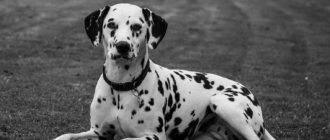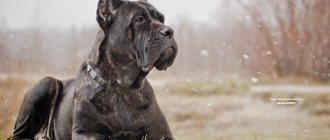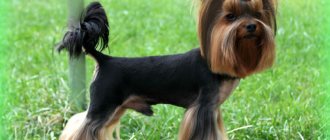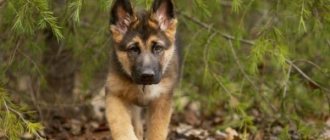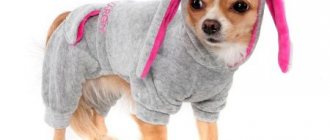The Dalmatian is one of the most beautiful and recognizable breeds in the world. Dalmatian puppies are born without spots - they acquire their characteristic color later. These dogs require proper training from a very early age. An interesting nickname will only emphasize the pet’s character.
Before buying a puppy, you should find out how to choose a pet, care for it, raise it and train it.
History of the Dalmatian breed
Dalmatian
Mention of spotted dogs is found in documents that have reached us from different eras and states, starting from ancient Egyptian papyrus scrolls. However, based on meager verbal descriptions, it is simply impossible to reasonably judge who exactly was the ancestor of modern Dalmatians.
The first more or less reliable evidence of the existence of the breed dates back to the 16th–17th centuries. White dogs with small dark markings are depicted in surviving religious and secular works of art from that time: the altar painting in the Church of St. Mary (also known as "Gospe od anđela") in a small town on the resort island of Lošinj, a fresco in the Franciscan monastery in Zaostrog, church frescoes Santa Maria Novella in Florence, ceremonial portraits by Venetian and Tuscan artists, depicting influential nobles - for example, Cosimo II de' Medici. Since much of the earliest evidence was found in the historical region of Dalmatia, which is now part of Croatia, it is from here that the roots of the breed are usually traced. And the obvious consonance of the names speaks in favor of this version, officially adopted by the FCI.
There, on the warm shores of the Adriatic Sea, some “theoretical” works also saw the light of day. The Roman Catholic Archdiocese of Djakovo-Osijek has preserved in its archives the chronicles of Bishop Petar Bakic (1719) and Andreas Kecskemeta (1739), both talking about Croatian-specific dogs Canis Dalmaticus. In 1771, the Welsh naturalist Thomas Pennant wrote the book Synopsis of Quadrupeds, where he first named the Dalmatian breed. In 1790, English natural history scholar Thomas Bewick included Dalmatians in his General History of Quadrupeds.
In general, it should be said that it was in Britain that immigrants from Dalmatia gained particular popularity. Researchers suggest that representatives of other breeds were used for breeding here, in particular, black pointers and white English terriers. The latter died out more than a hundred years ago, but had a hand in the creation of many modern breeds: Boston Terrier, American Bulldog, Bull Terrier, American Staffordshire Terrier and others. Through the efforts of Foggy Albion breeders, by the second half of the 18th century, the appearance of Dalmatians that is recognizable today was formed.
Dalmatian puppy
At the same time, the “Italian dogs,” as the British initially called them, noticed their amazing ability to run almost tirelessly over long distances, not inferior in speed to horse-drawn carriages. Fleet-footed dogs were made guards of valuable “movable property” during city trips and long journeys - a kind of prototype of modern car alarms. In addition, during the trip, four-legged drivers followed the horses and, with light bites, forced tired or lazy animals to maintain the pace set by the coachman. Since then, the definition of carriage dogs has been assigned to them for several decades.
Although the functions of Dalmatians were not limited to this. They guarded houses, helped hunters of small and large game, and served as “bodyguards” for noble ladies walking without male company. During the Regency era, spotted pets became a sign of the high social status of the owner.
Once overseas, the unusual dogs changed their roles and, instead of rich nobles, accompanied voluntary fire brigades, which, before the mass introduction of internal combustion engines, could not do without real “horsepower”. White “bells” visible from a distance served as a warning to other road users about the approach of fire fighters and helped clear the way just as well as sirens and light signals. But even after the fire-fighting carriages became museum exhibits, many did not want to part with their living talismans. Today, charismatic dogs are a recognizable symbol of US firefighters.
As for the exhibition history, dogs from Dalmatia were first presented to a professional jury and the public in 1860 in Birmingham. Thirty years later, a breeders' club was created and an official breed standard was formulated. Two years earlier, she was recognized by the American Kennel Club. The international canine organization FCI registered Dalmatians in 1926.
The first representatives of the spotted brethren appeared in Moscow in 1982, but breeding on the territory of the USSR progressed very slowly due to a lack of fresh blood. And the demand for puppies was small, since many dog lovers simply had no idea about the existence of the breed. Specialty clubs arose only at the dawn of the 90s. Today, the largest concentration of kennels and owners of Dalmatians is in the capital, St. Petersburg, Nizhny Novgorod, Yekaterinburg, Novosibirsk and some other cities.
Dalmatian appearance
Athletic and hardy, elegant dogs of medium to large size. Males weigh on average 18-27 kg with a height at the withers of 58-61 cm, females - 16-24 kg and 56-58 cm, respectively.
Head
Dalmatian face
The Dalmatian's head is proportional to the body. Long, flat, not too wide between the ears. The muzzle has a pronounced stop and is equal in length to or slightly shorter than the occipital part. There are no folds of skin on the head.
Ears
Moderately large, set wide on the head, pressed to the sides. Triangular in shape, tips slightly rounded. The color is necessarily spotted, matching the general coloring.
Eyes
Dalmatians have medium-sized, oval-shaped eyes. The color corresponds to the coat: dark brown for dogs with black spots, amber for dogs with brown spots. The look is clear and intelligent. The eyelids fit well to the eyeball. Their edges are well pigmented (depending on color - black or brown).
Nose
The lobe is wide, fully pigmented (black or brown in accordance with the base color), the nostrils are wide open.
Lips and teeth
The lips fit tightly to the jaw. The jaws are strong. The bite is scissor-shaped, with the upper teeth completely overlapping the lower teeth.
Neck
Strong, quite long.
Frame
The Dalmatian's body is well built, with muscular shoulders, a deep chest and well-arched ribs. The back is straight and powerful. The loin and croup are muscular, the slope is slight.
Limbs
The front legs are straight, elbows pressed to the body. The hind legs are muscular, the knees are strong and well developed. The paws resemble those of a cat: compact and round, with arched toes. The claws can be pigmented depending on the base color.
Tail
The Dalmatian's tail is quite long, spotted, and straight. It is thicker at the base and tapers towards the tip.
Wool
Short, dense, smooth, glossy, hard.
Dalmatian with brown spots
Dalmatian with black spots
Color
On a mostly white background there are black or brown (exactly the same color!) spots with clear contours, which are located symmetrically along the body, on the head, ears and tail.
Photo of an adult Dalmatian
Dalmatian character
Dalmatians are not suitable for inexperienced owners and people who need the company of a phlegmatic "couch" dog. Incredibly active by nature, without proper physical activity, they direct unspent energy into destructive pranks, causing damage to their homes. In such a situation, the animal becomes uncontrollable, it does not obey commands and completely ignores prohibitions.
Dalmatian plays with a child
Failure to understand the background of this behavior led to the formation of the erroneous opinion of low intelligence. If the Dalmatian does not respond to “No!” and “Come to me!”, this does not mean at all that he is stupid. The point is simply that the owner made serious mistakes when raising him, did not assert his authority and continues the chain of mistakes by not satisfying the natural needs of the pet for physical exercise.
Proper training, a balanced and calm relationship with the puppy, and early socialization contribute to the formation of a healthy and strong psyche. Such dogs perfectly sense a person’s mood and adapt to it, they are happy to follow commands, do not start fights in walking areas, are reserved with strangers, and are friendly towards animals.
Boss, you are the best!
Dalmatians do not become attached to one “their” person; they love and protect all household members equally, and at the same time strive to take an active part in everything that people do. They get along well with other pets, especially if they grow up with them. There is a long-standing craving for the company of horses in the genes, but few people today own a stable, so the company of a dog or cat would be suitable.
For a family with small children, the appearance of an energetic “plum pudding,” as the English affectionately call these dogs, can be a problem. But not because they are naturally aggressive and capable of deliberately harming the little one. On the one hand, impetuous and abrupt by nature, Dalmatians do not measure up to their strength and often knock down children who are inappropriately on the way. On the other hand, animals with hearing problems instinctively defend themselves from the “threat” when they are quietly approached from behind or disturbed in their sleep, and it is difficult for little ones to immediately learn the intricacies of handling a special family member.
But in most cases, Dalmatians get along just fine with older children and teenagers, feeling a kindred restless soul.
Popular nicknames for Dalmatians
It is important to choose a nickname for your pet. The name indicated in the pedigree is often long and difficult to pronounce, and it is used only for competitions and exhibitions. You need to name your Dalmatian so that the nickname is euphonious, does not irritate the pet and determines its character or intellectual qualities.
But you can look for a list of the most original names for Dalmatian puppies.
Puppy girl
Suitable nicknames for girls' Dalmatian dogs are:
- Anabel, Assol, Athena;
- Bonya, Barbie, Britney;
- Vanilla, Freckle, Vivienne;
- Gerda, Gloria, Goldie;
- Daphne, Daisy, Dolly;
- Josie, Zhuzha, Zhulya;
- Knopa, Khaleesi, Candy;
- Leia, Loki, Luna;
- Martha, Melanie, Molly;
- Nice, Nuri;
- Oxy, Olivia, Olive;
- Patricia, Prada;
- Riana, Rosie, Ruta;
- Sakura, Stasi, Stella;
- Terry, Tiffany, Tusya;
- Whitney, Una;
- Cherry, Chupa;
- Chanel, Sherry;
- Electra, Elsa, Angel.
Boy
Nicknames for boys Dalmatian dogs:
- Diamond, Aramis, Archie;
- Byron, Bucks, Bond;
- Vegas, Volt, Vulcan;
- Gunya, Goofy;
- Dante, Dario, Dolce;
- Zeus, Zephyr, Zidane;
- King, Compass, Cube;
- Like, Lord, Lotus;
- Michael, Mozart, Mason;
- Nick, Nels;
- Olympus, Oscar;
- Pepper, Pixel, Prince;
- Ralph, Richard, Romeo;
- Sky, Sparky, Snickers;
- Timmy, Timati, Toby;
- Chips, Chupa;
- Eclair.
Education and training
Dalmatians are one of the breeds for which proper training and early socialization are incredibly important. A freedom-loving character, unbridled energy, and hunter instincts without control and restraint mechanisms formed in childhood lead to the appearance of an uncontrollable, destructive adult animal.
Dalmatian training
Learning basic commands and interacting with the outside world cannot be put on hold. From the first days a puppy appears in your home, a training program should start. The little Dalmatian must clearly understand the boundaries of what is permitted and know that disobedience will have consequences. Of course, it is unacceptable to show aggression and use physical force, but the owner’s firm and stern voice, in which dissatisfaction is clearly expressed, is in itself sufficient punishment.
Do not forget that visits to walking areas and participation in group classes with a dog handler can only begin when the puppy has received the required doses of mandatory vaccines and sufficient time has passed for the formation of immunity to diseases dangerous to the pet. It's best to check with your veterinarian.
Well-trained dogs already know and easily carry out more than a dozen commands by the age of six months, including both standard and “artistic” ones such as successive flips, “High five!” or bows. In general, it must be said that spotted circus performers love attention and are ready to make a lot of effort to make their owners smile.
Mating, pregnancy, childbirth
The female comes into heat long before she is actually ready to bear puppies. Typically this occurs 14-25 days twice a year. The best time for conception is considered to be days from 9 to 14. At the moment of readiness for mating, the bitch’s discharge becomes lighter, and when stroked, she begins to move her tail to the side. If this is the first heat, the bitch should be bred no later than the 13th day.
On the day of mating, the girl is brought to the male dog's territory. Animals need time to get to know each other and, if circumstances permit, to play and run around with each other. The mating itself should be carried out in the presence of the owners of both pets.
To increase the likelihood of conception, it is best to repeat the meeting a day after mating.
The result of mating is visible approximately 2 weeks after the dogs meet. The bitch is not characterized by toxicosis, mood changes or food refusal. During pregnancy, the nipple halo and the back of the body expand. Later, you can notice a rounded belly.
The duration of labor directly depends on the number of puppies, as well as the time of their appearance. Usually the interval between the birth of a litter is 10-30 minutes. For the last puppies, this time may increase to 2 hours. If the birth is difficult, the owner can help the dog by carefully pulling out the already emerging puppy while pushing. Newborns are born in a bladder, which is either chewed by the dog or cut by the owner if the animal is unable to do so.
Care and maintenance
The ideal option for keeping a Dalmatian would be a spacious private house with a securely fenced area where he can roam freely during the day. However, it must be remembered that representatives of this breed cannot live permanently in an enclosure in our climatic conditions - short hair does not protect against low temperatures.
If you are the owner of a city apartment, long walks are a prerequisite for a peaceful existence. Moreover, not only the duration is important (at least an hour a day), but also the intensity of the load. It's best to have your dog on a leash accompany you on your run or bike ride - moving at a fast pace will burn off enough energy to not have to look for adventure when you return. An alternative could be exercises on an equipped obstacle course, just be sure to correctly measure the dog’s physical condition and the height of the barriers.
Dalmatians do not require complex and tedious care. Their “coat” does not fall off and does not need trimming or frequent washing, however, shedding occurs profusely and almost continuously, and becomes especially severe at the border of warm and cold seasons. To keep fur in the house to a minimum, it is recommended to brush your pet as often as possible (at least 2-3 times a week) with a brush or a special mitten.
Otherwise, standard procedures are enough: monitor the condition of the ears and eyes, the length of the claws, and regularly brush your teeth with veterinary paste. Nutrition should be balanced and healthy. The easiest way to achieve this is with ready-made premium and super-premium food. Remember that overeating combined with low physical activity can lead to obesity.
What to feed?
For normal growth, Dalmatians must eat properly. You need to choose natural, balanced food or special premium food for puppies. A balanced diet is a comprehensive menu consisting exclusively of healthy foods. If you give your puppy both at once, he will get an upset stomach.
The diet must include:
- boiled fish fillet and tender meat;
- fruits and vegetables;
- porridge;
- 2 eggs per week;
- cottage cheese;
- greenery.
Advice! Food must be complete and sufficient. If the puppy still asks to eat after eating, you need to increase the portion, and when there is food left in the bowl, then reduce it.
Dalmatian Health and Diseases
Dalmatian with heterochromia eyes
The average life expectancy of Dalmatians is 10-13 years.
The biggest problem of the breed is deafness. Hearing problems of varying severity occur in almost a third of dogs. 12% of Dalmatians are born completely deaf. An effective solution has not yet been found. Although only healthy animals are allowed for breeding, they also produce sick puppies. The latter, however, lead a full life as pets. This deficiency can be identified in the first weeks using modern tests.
Due to their metabolic characteristics, Dalmatians often develop bladder stones. They are also prone to skin allergies and hip dysplasia. Less commonly recorded are epilepsy, autoimmune liver diseases, osteochondrosis of the shoulder joint, osteomyelitis, dilated cardiomyopathy, hypothyroidism, laryngeal paralysis and other nonspecific diseases.
Since many diseases are hereditary or congenital in nature, their occurrence can be predicted taking into account the pedigree. Responsible breeders always provide comprehensive information about the health status of parents and grandparents.
Interesting Facts
Most newborn puppies do not have black spots.
There are several interesting facts about Dalmatians:
- puppies are born with perfect white coat color, spots appear later;
- black spots can be not only on the coat, but also in the oral cavity;
- The popularity of dogs has increased significantly after the release of the film 101 Dalmatians.
Dalmatians are very beautiful dogs that have a unique appearance. Before getting such a pet, you need to familiarize yourself with the characteristics of the breed, as well as its advantages and disadvantages.
How to choose a puppy
The key to a successful purchase is a balanced and carefully thought-out choice of breeder. Only nurseries with an impeccable reputation can guarantee that the new member of your family will be physically healthy and psychologically stable. Since Dalmatian puppies are given to permanent owners no earlier than 10-12 weeks, they have time to undergo the necessary medical examinations and show their character traits.
A good breeder will ask you as many questions as you ask him, because for him, every four-legged baby is not a living commodity, but an individual, so it is important to understand in what family he will live, in what conditions.
And you, in turn, have every right to meet the parents and study their documents, the veterinarian’s report on the puppy’s health condition and the results of the BAER test (Brainstem Auditory Evoked Response) - an electrodiagnostic hearing test.
It is important to see the conditions in which the mother and babies are kept, learn about nutrition and personally communicate with the puppy you like in order to evaluate its ability to make contact with people and adequately respond to the outside world.
Photos of Dalmatian puppies
How much does a Dalmatian puppy cost?
On private advertisement sites, they ask for a young Dalmatian “without documents” from 4 to 8 thousand rubles.
But you must understand that in this case it is impossible to know whether both parents were actually representatives of the breed you are interested in. And what is even more important, there is no guarantee that over time the animal will not develop certain pathologies that are life-threatening or significantly affect its quality. The price of Dalmatians in kennels varies in different regions and fluctuates even more significantly based on which class a particular puppy belongs to. Depending on individual characteristics and compliance with the breed standard, puppies from the same litter with FCI documents and veterinary passports will cost from 15-20 to 40-50 thousand rubles. And here it’s up to you to decide whether you plan to participate in exhibitions with the prospect of big victories or whether it’s enough that a devoted and mischievous friend appears in your home.
Diet
Meat is the basis of the diet
An ordinary Dalmatian, as well as a dwarf one, must eat properly and therefore it is necessary to understand in advance the diet for such dogs.
You can feed your dog the following foods:
- Meat. All dogs are carnivores and therefore need to be fed meat regularly. Moreover, it should be one third of the daily food intake.
- Cereals. The dog's menu must include cereals. It could be buckwheat, oatmeal or rice. Cereals promote the growth of puppies and also improve the functioning of the gastrointestinal tract.
- Vegetables. To ensure that dogs always have enough vitamins, they need to be regularly fed vegetables. Dalmatians easily digest cabbage, peppers, beets, zucchini, carrots and pumpkin.
- Fish. Several times a month, instead of meat, pets are given fish. At the same time, only sea fish can be given raw. River fish must first be boiled and the bones removed.
